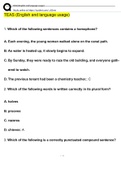Exam (elaborations)
AFL1501 Assignment 4 Semester 2 2024
- Course
- Institution
AFL1501 Assignment 4 2024 Assessment 4 Year Mark: 15°0 Task 1 Interpersonal Relationships (30) 1. Offer a discussion about how our identity is reflected in our language when we interact with others. To clarify your arguments, give examples from your personal experiences - 200-320 words (15)...
[Show more]












